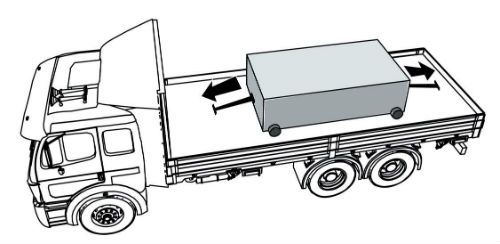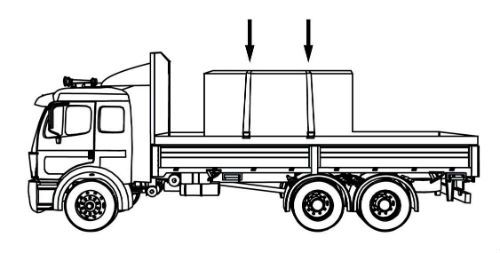CDL Practice Tests: Flatbed Cargo Securement
Choose A Section:
Go!The Aggregate Working Load Limit should, at minimum, be:
- 80% of the weight of the cargo.
- 100% of the weight of the cargo.
- Determined by the shipper.
- 50% of the weight of the cargo.
How much should the Aggregate Working Load Limit be?
The aggregate working load limit of any securement system must be at least 50% of the weight of the cargo being secured.
When loading bell pipe on one tier, all of the following apply except:
- Load bell pipe on one tier so that the bells all lie on one side of the vehicle.
- If the ends cannot be staggered, they must be aligned.
- Load bell pipe on one tier so that the bells alternate on opposite sides of the vehicle.
- If possible, the ends of consecutive pipe must be staggered within the allowable width.
One tier

Load bell pipe on one tier so that the bells alternate on opposite sides of the vehicle.
If possible, the ends of consecutive pipe must be staggered within the allowable width.
If the ends cannot be staggered, they must be aligned.
What is the Aggregate WLL of the securement system for a load secured with 7 tiedowns: 3 rated at WLL of 4,000 lbs, 2 at 6,500, and 1 at 8,000?
- 33,000 lbs
- 8,250 lbs
- 16,500 lbs
- 10,000 lbs
How do you calculate Aggregate Working Load Limit for tiedowns?
To calculate Aggregate Working Load limit, add together:
- 50% of the WLL of each end section of a tiedown that is attached to an anchor point.
- 50% of the WLL of each end section that is attached to the cargo
What types of freight need to be secured properly?
- Intermodal containers.
- Hazardous materials.
- Equipment used for vehicle operation.
- All freight should always be properly secured while driving.
-
Any cargo and dangerous goods/hazardous materials, including:
- All general freight.
- All equipment carried for vehicle operation.
- Intermodal containers and their contents.
- Some specific commodities have additional or different securement requirements (see later sections of this Handbook).
- Additional requirements under separate regulations may also apply for transportation of certain types of dangerous goods or hazardous materials.
Cargo
While driving, the freight must not:
- Obscure the driver's view ahead, left, or right.
- All of these things should be avoided.
- Prevent the exit of a person from the cab.
- Interfere with the free movement of the driver's arms or legs.
- Obscure the driver's view ahead or to the right or left sides (except for drivers of self-steer dollies).
- Interfere with the free movement of the driver's arms or legs.
- Prevent the driver's free and ready access to accessories required for emergencies. OR
- Prevent the free and ready exit of any person from the commercial motor vehicle's cab or driver's compartment.
A dunnage bag is:
- A structure, device, or another substantial article placed against or around an article to prevent horizontal movement of the article.
- An inflatable bag intended to fill otherwise empty space between articles of cargo, or between articles of cargo and the wall of the vehicle.
- A waterproof sheet used to cover cargo.
- A transverse load bearing structural component, particularly a part of a log bunk.
Dunnage bag:
An inflatable bag intended to fill otherwise empty space between articles of cargo, or between articles of cargo and the wall of the vehicle.
When using tiedowns to secure boulders, all of the following are requirements except:
- Use only chain to secure large boulders.
- Tiedowns should be located in valleys or notches across the top of the boulder.
- Boulders must be loaded as far back towards the rear as possible.
- Tiedowns must be arranged to prevent sliding across the rock surface.
Requirements

Use only chain to secure large boulders.
Tiedowns in direct contact with the boulder:

Should be located in valleys or notches across the top of the boulder
Must be arranged to prevent sliding across the rock surface.
Working Load Limit (WLL)is defined as:
- The acceleration due to gravity, 9.823 m/sec2 (32.2 ft/sec2).
- The maximum load that may be applied to a component of a cargo securement system during normal service, usually assigned by the manufacturer of the component.
- The number of hours that a tiedown can be used.
- The summation of the working load limits or restraining capacity of all devices used to secure an article on a vehicle.
Working Load Limit (WLL):
The maximum load that may be applied to a component of a cargo securement system during normal service, usually assigned by the manufacturer of the component.
What is the maximum weight that can be secured by a tiedown with a marked WLL of 5,000 lbs?
- 2,500 lbs
- 6,000 lbs
- 10,000 lbs
- 5,000 lbs
Note: The minimum WLL requirement for the securement system is 50%. More tiedown capacity should be used if you need to secure an article against any movement.
When securing metal coils, it is acceptable to use nailed blocking or cleats as the sole means to secure:
- Nailed wood cradles
- Timbers
- It is not acceptable.
- Chocks
The use of nailed blocking or cleats as the sole means to secure timbers, chocks or wedges, or a nailed wood cradle, is prohibited.
About The Flatbed Cargo Securement CDL Manual
Studying the flatbed cargo securement CDL manual is not a requirement for getting your CDL permit or license. It is required knowledge for flatbed drivers.
Some questions you should be able to answer for flatbed cargo securement:
- What is the minimum Working Load Limit of a tiedown used to secure logs?
- What is the minimum weight of a shipment of paper rolls that would require specific securement requirements?
- When securing concrete pipe over 45 inches loaded crosswise, which direction must the tiedowns on the front half of the load run?
- What is a cab shield?
- When securing concrete pipe over 45 inches loaded crosswise, which direction must the tiedowns on the rear half of the load run?
- What is a dunnage bag?
- Who is responsible for inspecting securing devices and cargo within the first 50 miles?
- How many tiedowns are required on a stack of shortwood loaded crosswise?
- What is the minimum working load limit of each tiedown used to secure crushed or flattened vehicles?
- Define 'bolster'
- What is a hook-lift container?
- When a tiedown is attached directly to the cargo, what is the ideal angle where it attached to the vehicle?
What is a securing device?
Any device specifically manufactured to attach or secure cargo to a vehicle or trailer:
- Synthetic Webbing
- Chain
- Wire rope
- Manila rope
- Synthetic rope
- Steel strapping
- Clamps and latches
- Blocking
- Front-end structure
- Grab hooks
- Binders
- Shackles
- Winches
- Stake pockets
- D-rings
- Webbing ratchet
- Bracing
- Friction mat
What is a tiedown?
A combination of securing devices that forms an assembly that:
- Attaches cargo to, or restrains cargo on a vehicle.
- Is attached to anchor point(s).

Some tiedowns are attached to the cargo and provide direct resistance to restrain the cargo from movement.

Some tie-downs pass over or through the cargo. They create a downward force that increases the effect of friction between the cargo and the deck. This friction restrains the cargo.
 Related Cargo Securement Terms That Every Driver Should Know:
Related Cargo Securement Terms That Every Driver Should Know:
-
Tiedown:
A combination of securing devices which form an assembly that attaches cargo to, or restrains cargo on, a vehicle or trailer, and is attached to anchor point(s).
-
Contained:
Cargo is contained if it fills a sided vehicle, and every article is in contact with or sufficiently close to a wall or other articles so that it cannot shift or tip if those other articles are also unable to shift or tip.
-
Blocking:
A structure, device, or another substantial article placed against or around an article to prevent horizontal movement of the article.
How should tiedowns be attached?
Tiedowns can be used in two ways:
-
Attached to the cargo:
- Tiedowns attached to the vehicle and attached to the cargo.
- Tiedowns attached to the vehicle, pass through or aroundan article of cargo, and then are attached to the vehicle again.
-
Pass over the cargo:
- Tiedowns attached to the vehicle, passed over the cargo, and then attached to the vehicle again.
Tiedown placement:

Place the tiedown as close as possible to the spacer.
Position the tiedowns as symetrically as possible over the length of the article.

Position the tiedowns to preserve the integrity of the article.







 TT On Facebook
TT On Facebook